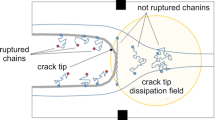Abstract
A novel theory has been developed which directly relates the abrasion of rubber by a knife edge to its crack-growth characteristics. The approach is based on fracture mechanics which has been successfully used to interpret other failure processes in rubbers. The theory treats the removal of the rubber when a steady state has been reached in the development of the abrasion pattern in the rubber surface. It is suggested that crack growth occurs into the rubber from stress concentrations in the abrasion pattern. An important point is that once a steady state is established the detailed way in which the particles of rubber are finally detached is unimportant. The crack growth behaviour of the rubber is measured independently using established techniques.
The experimental apparatus is described and results have been obtained at various loads and sliding speeds. Good agreement with the theory is found for most rubbers but departures are noted for natural rubber which crystallizes on straining. The reasons for these departures are discussed.
Access this chapter
Tax calculation will be finalised at checkout
Purchases are for personal use only
Preview
Unable to display preview. Download preview PDF.
Similar content being viewed by others
References
A. Schallamach, Wear, 1, 384, (1958).
K. A. Grosch and A. Schallamach, Rubber Chem. and Technol., 39, 287 (1966).
I.V. Kragelskii, Soviet Rubber Technol., 18, 22 (1959).
I.V. Kragelskii and E. F. Nepomnyashchii, Wear, 8, 303, (1965).
S. B. Ratner, Dokl. Akad. Nauk USSR, 150, 848 (1963).
G. I. Brodskii, N. L. Sakhnovskii, M. M. Reznikovskii and V. F. Evstratov, Soviet Rubber Technol., 19, 22 (1960).
A. Schallamach, Proc. NRPRA Jubilee Conf. Cambridge, L. Mullins, ed., Maclaren, London (1965).
A. Schallamach, J. Appl. Polymer Sci., 12, 281 (1968).
R. S. Rivlin and A. G. Thomas, J. Polymer Sci., 10, 291 (1953).
A. G. Thomas, J. Appl. Poly. Sci., 3, 168 (1960).
A. G. Thomas, J. Polymer Sci., 31, 467 (1958).
G. J. Lake and P. B. Lindley, Rubb. J., 146, (10) 24 and (11) 30 (1964).
A. N. Gent, P. B. Lindley and A. G. Thomas, J. Appl. Poly Sci., 8, 455 (1964).
A. Schallamach, Trans. Inst. Rubber Ind., 28, 256 (1952).
A. Schallamach, J. Poly. Sci., 9, 385 (1952).
P. B. Lindley and A. G. Thomas, Proc. 4th Rubb. Technol. Conf. London, 428 (1962).
J. I. Cunneen and G. M. C. Higgins, Chemistry and Physics of Rubber-Like Substances, L. Bateman, ed., Chapter 2, Maclaren (1963).
Author information
Authors and Affiliations
Editor information
Editors and Affiliations
Rights and permissions
Copyright information
© 1974 Plenum Press, New York
About this chapter
Cite this chapter
Champ, D.H., Southern, E., Thomas, A.G. (1974). Fracture Mechanics Applied to Rubber Abrasion. In: Lee, LH. (eds) Advances in Polymer Friction and Wear. Polymer Science and Technology, vol 5. Springer, Boston, MA. https://doi.org/10.1007/978-1-4613-9942-1_6
Download citation
DOI: https://doi.org/10.1007/978-1-4613-9942-1_6
Publisher Name: Springer, Boston, MA
Print ISBN: 978-1-4613-9944-5
Online ISBN: 978-1-4613-9942-1
eBook Packages: Springer Book Archive




